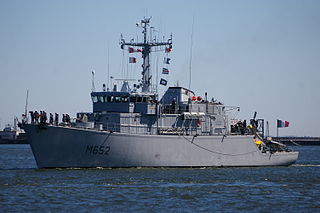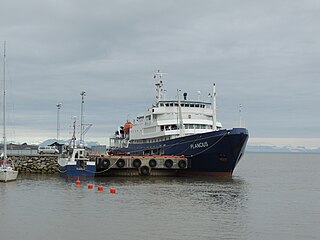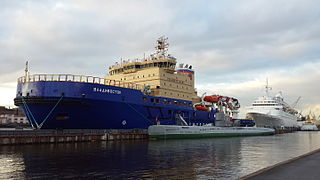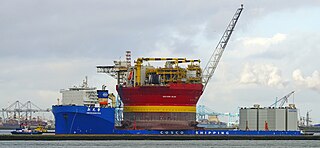
The Floréal class is a type of light "surveillance frigates" designed for the needs of the French Navy in low-threat environments ordered in 1989. The ships are named after months of the Republican Calendar. They use construction standards of commercial ships. The frigates were built between 1990 and 1993 by the Chantiers de l'Atlantique at Saint-Nazaire, France. The six French ships of the class, Floréal, Prairial, Nivôse, Ventôse, Vendémiaire and Germinal, remain in active service.
Gallia Belgica was a province of the Roman Empire covering present-day Luxembourg and parts of France, Belgium and the Netherlands.

The Tripartite class is a class of minehunters developed from an agreement between the navies of Belgium, France and the Netherlands. A total of 35 ships were constructed for the three navies. The class was constructed in the 1980s–1990s in all three countries, using a mix of minehunting, electrical and propulsion systems from the three member nations. In France, where they are known as the Éridan class they are primarily used as minehunters, but have been used for minesweeping and ammunition transport in Belgium and the Netherlands, where the Tripartites are known as the Alkmaar class.

The Holland-class ocean-going patrol vessels are a class of four ocean-going patrol vessels constructed for the Royal Netherlands Navy. They are designed to fulfill patrol and intervention tasks against lightly armed opponents, such as pirates and smugglers, but have much higher level electronic and radar surveillance capabilities which are used for military stabilization and security roles, short of outright war. Without sonar or long range weapons, they utilize the surveillance capabilities of the Thales integrated mast, which integrates communication systems and two four-faced phased arrays for air and surface search.
Lodbrog is a 10,243 GT cable-laying ship that was built as a freight ferry. She was built in 1983 as Siegelberg and completed in 1985 for Romanian owners as Tuzla. In 1996 she was renamed Bolero. The ship was renamed Lodbrog after conversion to a cable layer in 2001.

TIVMPI Resolution is a wind turbine installation vessel deployed to install turbines at offshore wind farms. It was the first self-elevating Turbine Installation Vessel in the world. She can raise herself on her six legs between 3 metres (10 ft) and 46 metres (151 ft) above the sea.

The Centauro-class patrol boat is a series of four patrol boats in service with the Portuguese Navy. It is an evolution of the preceding Argos class. This class is meant for fisheries inspection and control duties mainly in the Mainland Portugal shores – with some sporadic presence in the Madeira Archipelago. The Centauro class is Portuguese-designed and built at the Arsenal do Alfeite (Almada) and Estaleiros Navais do Mondego.
YM Uranus is a tanker registered under the Maltese flag. It was involved in a collision on 8 October 2010 off the coast of Brittany, France.

Athena was a 7,805 GT factory ship which was built in 1992. In October 2010, she caught fire off the Isles of Scilly. In May 2011 she caught fire while lying at the harbour of Runavík in Skálafjørður, Faroe Islands. It happened at night, and people who lived on the other side of the fjord, where the smoke was headed, were evacuated. Some months later the ship was sold to Smedegaarden in Esbjerg, which took her apart.

MV Plancius, formerly HNLMS Tydeman (A906), is a renovated oceanographic research vessel of the Royal Netherlands Navy now employed as a polar expedition cruise vessel by owner and operator Oceanwide Expeditions. She was commissioned into the Royal Netherlands Navy on 10 November 1976, and served until 2004, before being renovated for commercial use. The vessel was used for both military and civilian research and had a fracture zone named after it.
Arcticaborg (Арктикаборг) is an icebreaking platform supply vessel. She was previously operated by Wagenborg Kazakhstan in the Caspian Sea but was transferred to Canada in 2017 and acquired by Fathom Offshore in 2018. In 2019, she was contract to Russia for two years.
Georgiy Sedov is an icebreaking platform supply vessel operated by Rosmorport in the Sea of Azov. She was built by Kværner Masa-Yards in Helsinki, Finland, in 1998 as Antarcticaborg for Wagenborg Kazakhstan to be used in the Caspian Sea.

Drazki is a Wielingen-class frigate of the Bulgarian Navy. Originally constructed for and operated by the Belgian Naval Component as Wandelaar, the frigate was designed as a platform capable of multiple uses as an escort during the Cold War in the North Sea and English Channel. The vessel uses weapons and sensor technology from NATO counterparts, which was one of the reasons the ship was acquired by the Bulgarian Navy in 2004. The frigate is currently in active service.

Moskva is a Russian Project 21900 diesel-electric icebreaker. Built at Baltic Shipyard in 2008, she was the first non-nuclear-powered icebreaker built in Russia after the dissolution of the Soviet Union.

Novorossiysk is a Russian Project 21900M diesel-electric icebreaker. She was built by Vyborg Shipyard in Russia and delivered to Rosmorport in 2016.

MS A Wind is a Ro-Ro and passenger ship, which operated on the Vuosaari–Muuga route. The ship was built in 1972 Helsingørs Skipsværft dock in Helsingør. The vessel is registered under the Cameroon flag.
Miscaroo was an icebreaking anchor handling tug supply vessel built by Vancouver Shipyards for BeauDril, the drilling subsidiary of Gulf Canada Resources, in 1983. She was part of a fleet of Canadian icebreakers used to support offshore oil exploration in the Beaufort Sea. In the 1990s, the vessel was acquired by Canadian Marine Drilling (Canmar) and renamed Canmar Miscaroo. In 1998, she was purchased by Smit International and served in the Sakhalin oil fields as Smit Sakhalin until 2017 when the 34-year-old icebreaker was sold for scrapping in China.

Vladivostok is a Russian diesel-electric icebreaker and the lead ship of Project 21900M icebreakers. She was built by Vyborg Shipyard in Russia and delivered to Rosmorport in 2015.

MV Xin Guang Hua is a semi-submersible heavy-lift ship operated by COSCO Shipping. She is the largest Chinese vessel of her type and the second-largest in the world, exceeded only by BOKA Vanguard.

Mudyug is a Russian icebreaker and the lead ship of a series of three subarctic icebreakers built at Wärtsilä Helsinki shipyard in Finland in 1982–1983. The vessel's non-rebuilt sister ships are Magadan and Dikson.














